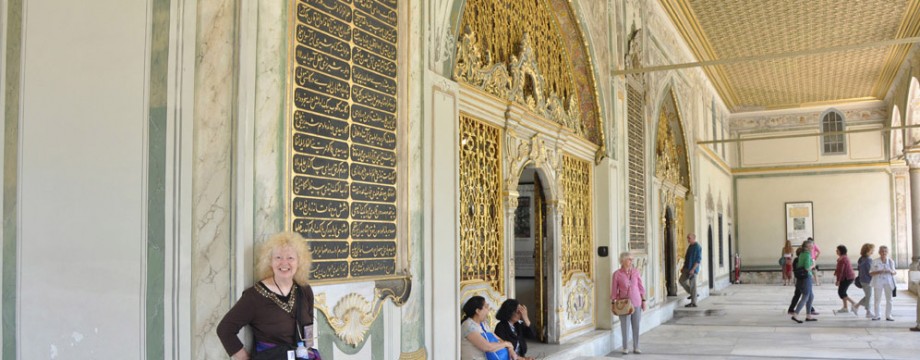Hawaii Photo Book (50 years)
In 2023 I’m celebrating 50 years in Hawaii with my new book: Hawaii Through My Lens: 50 Years Photographing the 50th State. From old black/white images in the 1970s, to Jack Lord and local actors on Hawaii Five-0, and the set of the movie “Waterworld” floating in Kawaihae harbor on the Big Island, to paniolo (cowboys) and rodeos, to parades, to an erupting volcano, black-sand beaches and sunrise from the top of Haleakala, to Makahiki and Hawaiian cultural practices, to Lahaina, the way it used to be before the fire, and much more. This is my photo love letter to the islands of Hawaii (paperback and e-book): amazon.com (search: Hawaii Through My Lens). What do you remember and love about Hawaii?

Categories: Books, culture, Hawaii, History, nature, Photography, Published Work, travel Hawaii, Uncategorized
Tags: Hawaii, history, photography, photos
Leave a comment
Adventures in China
Join me on a pictorial tour of the Seven Kingdoms, now known as China. https://www.amazon.com/Adventures-China-Jennifer-Crites/dp/B0BCD849LX/ref=tmm_pap_swatch_0?_encoding=UTF8&qid=1662188032&sr=8-1

Before Roe v. Wade
It was morning sickness. Susan’s mother knew immediately. Susan had no idea. She’d met her 24-year-old boyfriend, Jim, at the hospital where she worked part-time as a nurse’s aide. He’d been a visitor. Susan was 17 and had never had a boyfriend. Other than the time Jim took her to play pool and she won the game—he never took her again after that—their dates were usually at his apartment. Sometimes they’d swim in the pool, but mostly they stayed in.
Susan was a virgin. Jim changed that. It hurt, and all the times afterwards made her uncomfortable. She didn’t know how to say ‘no’ to him, was afraid, but of what she wasn’t sure. She just complied because that’s what he wanted. She had no idea, no one had ever taught her, that what they were doing could cause pregnancy.
Once she found out she was pregnant, she told Jim. He came over to her parents’ house. They sat on the couch together. And he told her parents that he and Susan had decided not to get married, even though Susan knew they had never discussed it. He also said he thought she should have the baby. He was Catholic, after all. Then he disappeared.
Susan’s mother, a nurse, talked to some of the doctors she knew and they gave her the name of a clinic in Nogales, Mexico. Once arrangements had been made, Susan’s Dad took her to Arizona and they crossed over the border. Susan had learned a little Spanish in school. As they walked along the dusty streets, she queried people, “Donde esta el hospital?” (where is the hospital).
She doesn’t remember much—just waking up on a table, seeing bright lights and some people in white coats and masks around her, then passing out again.
Afterwards, her Dad took her back across the border. They stayed in a motel that night and flew home the next day. No one ever spoke of it again.
Susan was lucky. Other girls in the same situation got their abortions from backstreet abortionists in their towns or cities. Often coat hangers were used. Some girls suffered horribly. Others died.
Categories: Uncategorized
2 Comments
Revenge of the Shark God—1
“In Hawaiian lore, an eclipse foretold of imminent disaster—a war perhaps, or the death of some high chief. As the earth’s shadow gobbled up the moon, light from distant stars hesitated at the thick layer of cumulus clouds drifting over the island of Oahu. Below the clouds, illumination from a single street lamp filtered through slotted blinds into an office at the Honolulu Aquarium. On the floor, a woman lay unconscious, her wrists and ankles bound with eighty-pound-test fishing line.”
This is the beginning of my mystery-detective novel. What follows is a thrilling adventure that takes our heroine, HPD Detective Lily Graham, from Oahu to the Big Island of Hawaii, where she works to solve the murder of a prominent socialite found dead in the aquarium shark tank.

From a descriptive review on amazon: “James Bond has nothing on Detective Lili’uokalani, or Lily, Graham who doggedly pursues the murderer of a wealthy socialite found floating belly-up in an aquarium. She narrowly escapes death in several heart thumping instances refusing to let the killer get away. She gets into trouble with the law herself breaking all the rules to get to the bottom of the crime. The story is set in contemporary Hawai’i. Snippets of Hawaiian mythology are sprinkled throughout in the telling. The author cleverly informs the reader of Hawaiian culture and tradition without being pedantic. Pidgin (the local dialect) in the dialogue gives an authentic feel to the characters. There is a pinch of magical realism hinting at spirit intervention that is in keeping with Hawaiian mythology. I was impressed with the author’s deep knowledge of the culture. If you have been to Hawaii, you will recognize physical locations detailed with great accuracy. I loved being on the Islands with Lily and friends and was totally caught up in the chase.”
Categories: mystery/detective novel, thriller
Tags: action/adventure, adventure, detective, Hawaii, mystery, thriller
2 Comments
Hawaiian Mystery-Detective book
If you’re looking for a great mystery that’s hard to put down, please give this one a look. It has action, adventure, sharks, a hired killer, grave robbers and other great characters, plus lots of twists and turns. I think you’ll like it: https://www.amazon.com/Revenge-Shark-God-Jennifer-Crites/dp/B09H95KQL1/ref=sr_1_1?keywords=Revenge+of+the+shark+god&qid=1638766346&sr=8-1
Here are a couple of reviews for this book:
“James Bond has nothing on Detective Lili’uokalani, or Lily, Graham who doggedly pursues the murderer of a wealthy socialite found floating belly-up in an aquarium. She narrowly escapes death in several heart thumping instances refusing to let the killer get away. She gets into trouble with the law herself breaking all the rules to get to the bottom of the crime. The story is set in contemporary Hawai’i. Snippets of Hawaiian mythology are sprinkled throughout in the telling. The author cleverly informs the reader of Hawaiian culture and tradition without being pedantic. Pidgin (the local dialect) in the dialogue gives an authentic feel to the characters. There is a pinch of magical realism hinting at spirit intervention that is in keeping with Hawaiian mythology. I was impressed with the author’s deep knowledge of the culture. If you have been to Hawaii, you will recognize physical locations detailed with great accuracy. I loved being on the Islands with Lily and friends and was totally caught up in the chase.”
Dec. 8, 2021: “
I can’t thank the author enough for sweeping me up in this Hawaiian mystery, “Revenge of the Shark God”. This tale not only engulfed me with intrigue but managed to make me feel like I was in the Hawaiian Islands soaking up the culture and scenery. Jennifer Crites knowledge of the local customs and culture wraps you in a sense of reality as the mystery unfolds. This will be one I read more than once.

Categories: mystery/detective novel
Tags: action, action/adventure, detective, Hawaii, mystery
8 Comments
Take Better Pictures: Photo Class in a Book
My new book is finally here, includes hundreds of photos, lots of advice/tips for both DSLR and cell-phone-camera users, and can be found at: https://www.blurb.com/b/9590931-how-to-take-better-pictures-photo-class-in-a-book
Exploring North Vietnam: HaLong Bay—a Seaplane Ride, Cruise, Cave, and Pearl Farm
Our last stop in Vietnam was HaLong Bay—a fairyland of 1,600 odd-shaped, karst limestone mini-mountains rising out of the sea. It was first recorded as a UNESCO World Heritage Site in 1994, and in 2000, the bay, with its significant geomorphic features, was recognized for the second time as a billion-year-old living proof of Earth’s formation.
HaLong means “descending dragon.” In myth, the bay was created by a dragon that thrashed around the land on the edge of the ocean, breaking it up and creating the bay’s islands. According to geology, at the end of the last ice age when the glaciers melted, the sea level rose, inundating the area and turning hills into islands
To really experience this famous place, we booked a 3-day cruise with Paradise Cruises, but our first adventure when arriving was a seaplane ride over the bay with Hai Au Aviation out of Tuan Chau Marina. The views were magnificent. That night, we stayed in Paradise’s hotel on shore and enjoyed the music of musicians playing traditional Vietnamese instruments.
By the next morning, I had fallen sick again with what appeared to be a bad cold, but I knew if I could just make it to the ship, I could get to our stateroom with my last few ounces of energy. There I stayed for the 3 days, mostly bundled up and relaxing on the balcony, enjoying the scenery, and chatting with a lovely young Vietnamese woman who brought me B,L, and D (she said she was looking for a Caucasian husband like “Sir”—which is what she called Jerry—) while Jerry went off on the excursions and took lots of great photos.
The first excursion was to Sung Sot Cave—the largest and most spectacular grotto/cave in Vietnam. Discovered by the French in 1901 (when France controlled Vietnam as part of French Indochina) and originally named “Grotte des Surprises,” it’s approximately 25m (and 50 steps) above sea level, and 10,000 square meters large, comprising two chambers. The second chamber can hold a thousand people at one time.
Jerry also climbed the 400 steps to the observation deck at the summit of Ti Top Island, named after a visit by famous Russian cosmonaut Gherman Stepanovich Titov. He was the second person to orbit the earth and first to spend an entire day in space. His statue is on the island.
One of our ship’s tenders took Jerry to a pearl farm to see how pearls are grown, and he also went by rowboat to a floating fishing village, Cua Van, which is comprised of 100 households and 733 people. Every day, locals roam around the village by boat to collect garbage and floating waste to reduce the risk of water pollution.
Actually, when we pulled into the Tuan Chau Marina, I was sad to leave such a beautiful place. A pre-arranged car took us back to Hanoi to a tiny hotel Jerry had found near the airport. Cost: $14/night, and that included a lavish breakfast and that delicious Vietnamese egg coffee. It was a memorable 3-week visit to N. Vietnam, during which we gained some understanding of this country and its friendly people. It was also another reminder that people all over the world are the same underneath skin color and customs.
Click on a photo, then arrow to move back and forth. Enjoy.
Categories: Asia, cruises, culture, nature, Photography, seascape, Travel, Uncategorized, Vietnam
Tags: aerial photography, Asia, caves, culture, environment, fishing boats, Halong Bay, islands, pearl farm, photography, scenic, travel, Vietnam
Leave a comment
Exploring North Vietnam: Ninh Binh—Three Caves, a River, and an Animal Sanctuary
On this two-day trip out of Hanoi, we passed trucks loaded with pigs, and dozens of duck farms, all supplying restaurants in Hanoi. At the Cuc Phuong National Park’s conservation center, we were hoping to spot a pangolin (a rare, scaled animal that, in photos, reminded me of an armadillo), but they were only on view at certain times of day, so we missed them. We did visit the monkey and turtle sections though. After a night in our Ninh Binh hotel, we visited a temple and then boarded a small, flat-bottomed boat for another river trip where all the rowers used their legs and feet at the oars. Dozens of tourist-filled boats joined us as we made our way down the river, past even more spectacular scenery, and through three low-hanging caves. I was sure we would have to duck or bump our heads, but the rowers knew the safest channel to take. Outside the caves we encountered a floating market of sorts. Several sellers in boats tried to entice us to buy their wares, imploring us to at least buy food for our rower.
Categories: Agriculture, Animals, Architecture, Art, Asia, Birds, culture, environment, flowers, History, nature, Photography, Travel, Uncategorized, Vietnam
Tags: animal sanctuary, animals, caves, conservation, culture, goats, monkeys, people, photography, religion, river caves, rivers, rowing, scenic, temple art, temples, travel, turtles, Vietnam, water buffalo
Leave a comment
Exploring Vietnam: Yen River & Pagoda
On a day trip from Hanoi, we headed southwest, ostensibly to visit the Perfume Pagoda in a Huong Son mountain cave. The only way to get there, following a 2-hour drive, is a boat ride along the Yen River, then a cable car up to the cave—a pilgrimage site to which thousands go during the religious Tet festival in March and April.
The drive out of Hanoi showcased Vietnam’s watery countryside. When we arrived at the river, the tiny boat was big enough for us, our guide, and the boat’s rower, and the one-hour trip upriver proved serene and scenic. We passed watery fields of pink lotus blossoms (which apparently start closing at noon), travelers in other boats, a red foot bridge high above the river, and kingfisher birds clinging to branches, before arriving at the elaborate Thien Tru Pagoda temple complex. Fortunately, we were there in November, and the place was almost deserted—a situation that was perfect for exploring and photography but posed some problems: The Ladies restroom was locked, so I had to use the Men’s, while our guide stood guard outside. Also, we were told that the cable car was not running (not enough people, I suppose), so we couldn’t go up to the Perfume Pagoda. After a bountiful lunch, we explored the extensive temple complex, then rejoined our boat and rower for the trip back down the river. By this time, all the lotus blossoms had closed, but the scenery was still spectacular.
Please enjoy! Just click on a photo to enlarge, then arrow back and forth.
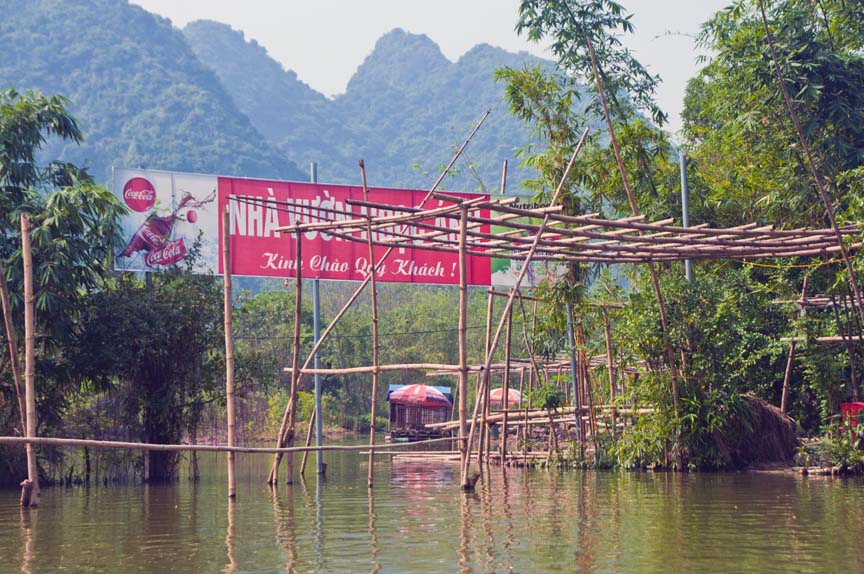
Categories: Architecture, Art, Asia, Birds, culture, environment, flowers, nature, Travel, Uncategorized, Vietnam
Tags: birds, history, kingfisher, people, photography, reflections, religion, rivers, scenery, temples, travel, Vietnam
Leave a comment
Exploring North Vietnam: Sensational Sapa
About five hours drive (or 8 hours overnight train trip) north of Hanoi is the mountain hideaway town of Sapa, in the shadow of Fan Si Pan—one of Vietnam’s tallest mountains. This is a land of steep hillside rice terraces and colorfully dressed hill tribes like the Black Hmong and Dao. There’s a beautiful lake, of course, French colonial buildings, and a town that’s constantly under construction (like the rest of Vietnam). We roamed the town, took in a buffet dinner and dance show at our hotel, and visited an eclectic mostly-outdoor market. I had come down with a bad case of bronchitis, so couldn’t hike to the hill-tribe villages as we had planned. A local doc gave me some antibiotics, which perked me up for awhile.
So, let me take you on a photo tour of Sapa. As always, click on any photo to enlarge and then arrow back and forth. Please enjoy.

Categories: Architecture, Art, Asia, History, Photography, Shopping, Travel, Uncategorized, Vietnam
Tags: architecture, clothing, costumes, culture, dance, food, history, markets, music, musical instruments, people, photography, Sapa, travel, Vietnam
2 Comments
Exploring Hanoi Part III: A Couple of Fascinating Museums
Normally, I avoid museums. No matter how revealing the dishes, weapons and other elements of a past civilization are, looking into little plexiglas cases does not excite me. I am definitely interested in how people of the past lived, worked and spent their time, but a hands-on exhibition is more my style. That’s why I loved Hanoi’s Ethnology and War Museums. At the Ethnology Museum, I admit we skipped the indoor exhibits (in plexiglas cases) for a chance to wander around the recreated villages outside.
Some notes about three of the houses. The communal house is 19 meters in height including 3 meter stilts. Its floor area is more than 90 square meters.
A team of 40 Bahnar people came from Kon Rbang Village in Kontum City, in the Central Highlands, to build this house. It was modeled after the village’s early 1920’s communal house. The most important tool in its construction is the axe, which is used to cut the wood and carve the trunks. The axe can also be used as a chisel to mortise the columns.
The high roof is supported by eight massive pillars, four of which are 60cm in diameter. The structure is composed of many other posts and beams arranged horizontally, vertically or diagonally at different heights. They serve to both connect and support the house. The longitudinal beams and purlins are 14 to 15m long. The sloping and curved roof is rounded at its lower part. It is not only attractive, but also helpful for wind resistance. This curve brings lightness, elegance, and the impression of a greater height.
Role of the communal house
The communal house has a significant meaning in villages. It is the largest and the most spectacular architecture, showing the power and talent of the community.
Traditionally, the communal house was used for social and ceremonial activities. It was a place for guests to be received, for men to be together during their free time, for the elderly to transmit knowledge to younger generations, for old villagers to deal with village affairs, and for villagers to concentrate together in community events. Collective rituals were also held at the communal house. In the past, the youth were on duty here to prepare for fights or to defend the village. Young bachelors and widowers also spent nights in the communal house. Women did not usually enter this house.
Heads of sacrificed buffalos and hunted animals are often hung in the communal house. These are the trophies and pride of the community. Other ritual objects and protecting talismans of the villages are also preserved in the communal house.
EDE Longhouse
The long house is 42.5 meters long and 6 meters wide and sits on one meter high stilts. It was reconstructed at the Museum in 2000. It was originally built in 1967 and belonged to Mrs. HDiah Eban’s family (Ede Kpa) in Ky Village, Buon Ma Thuot city, Dak Lak Province in the Central Highlands.
The house is oriented in a north-south direction according to Ede tradition. The north side is the front with the main entrance. The south end was where families lived. As a house of a powerful family, it was built with big columns and beams, on which many decorations were carefully carved. Its original staircase, over one meter wide, was carved from one large wooden board.
Traditionally, extended matrilineal families lived in long houses. The more people who lived in a house, the longer it was. Some houses were 200m long. In the 1970s, there were still houses 50m to 60m in length. Since the 1980s, extended families have split into nuclear ones that live in smaller houses.
Giarai tomb house
The tomb house was built in 1998 by five Giarai Arap men from Mrong Ngo Village, ChuPa District, Gia Lai Province.
About thirty dead people can be burried in this large tomb house in the village. The decorated sculptures are carved from tree trunks using axes, chisels, and knives. Statues of men and women showing off their secret parts, and pregnant women symbolise fertility and birth. The wooden roof is covered with plaited bamboo planks on which designs are painted with natural red pigments. Figures on the roof depict activities of the tomb abandoning ritual.
It is thought that the tomb house is for the dead in the afterlife. Broken dishes, bottles, cups and trays, and wooden models of tools are put inside the tomb to provide necessities to the deceased in their other world. After the ritual, the tomb is abandoned.
The War Museum
This was our biggest surprise. I didn’t expect to like it, but the exhibits were extremely well done, with actual tanks and shot-down U.S. planes, as well as recreated scenes indoors of wars throughout Vietnam’s history. Check out the exhibit of a battlefield with men crawling through tunnels below. Also a bicycle equipped with a rocket launcher. The country was constantly fighting off invaders.
Categories: Architecture, Art, Asia, culture, History, museums, Photography, Travel, Uncategorized, Vietnam
Tags: architecture, culture, Hanoi, history, museums, photography, travel, Vietnam, Vietnam war, war
Leave a comment
Exploring Hanoi’s Old Quarter: Part II
More photos from Hanoi, including beautiful tiled artwork along roads and streets, lots of scooters of course, graduation (high school, I think) pictures at the Temple of Literature, cows in the street, the country’s tall and skinny apartment buildings, temples, soldiers in formation at Ho Chi Minh’s mausoleum (his body is taken to Moscow once a year for refurbishing), and me with a group of delightful school children who were passing through a temple complex on their way home.
If you cursor over the photos, you’ll see the captions. Click on a photo, it will enlarge, and you can arrow your way forward or backward. Please enjoy.
Categories: Architecture, History, Photography, Travel, Uncategorized, Vietnam
Tags: architecture, food, Hanoi, history, people, photography, photos, travel, Vietnam
2 Comments
Vietnam—Exploring Hanoi’s Old Quarter: Part I
I was in high school/college in California while the Vietnam war had been raging for ten-plus years, and I knew many young men who were drafted into the army and sent to this far-away country. Years earlier, the U.S. had teamed up with other UN countries to stop communist North Korea from taking over democratic South Korea (remember the tv show, MASH?). In Korea’s case, the UN forces were able to push back the N. Korean forces to the 38thParallel, where the country remains divided to this day. I suppose, when the U.S. went into Vietnam with the same aim (to keep the North Vietnamese Communist party out of South Vietnam), they felt it was doable. But this time, the U.S. was alone, without the backing of UN troops. As we now know, the war in Vietnam was a disaster for both the Vietnamese people and U.S. soldiers. The Communist north took over the south, many Vietnamese U.S. collaborators were killed, and I’ll never forget the news videos of panicked crowds trying to get on the last U.S. planes to leave Vietnam.
Since then, Vietnam has fostered good relations with the U.S. and has welcomed tourists from all over the world. Even so, memories of the war-ravaged country remained in my mind, and since it is a Communist country, I wasn’t sure what to expect when Jerry and I traveled there last November (2019).
We had taken a southeast Asia cruise a few years earlier and joined excursions to central and south Vietnam, but we had never seen the North.
So please join me as I take you on a virtual tour of North Vietnam, starting with its capital, Hanoi. As far as I could tell, there is no central transportation in Hanoi. Everybody, and I mean everybody, rides mopeds or bicycles, but mostly mopeds (tourists can take rides in pedicabs (called cyclos). It must be the moped capital of the world. Crossing a street in the Old Quarter of Hanoi, you must watch for a good open spot, step out onto the street and keep going. If you don’t stop or hesitate or waiver in your direction, the moped riders and any other vehicles will swerve around you. It takes getting used to.
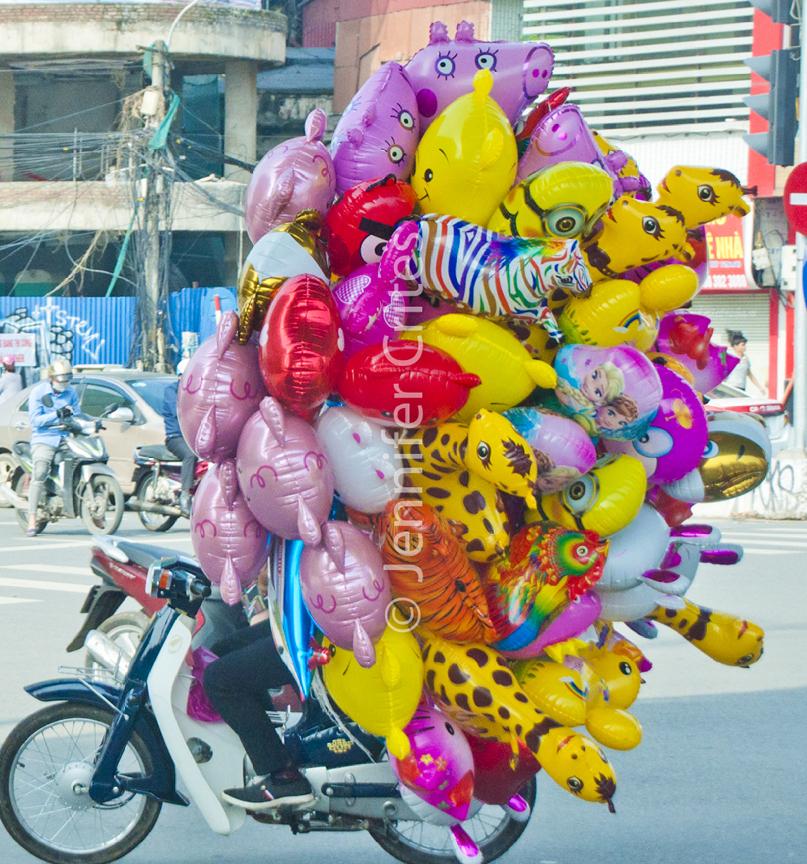

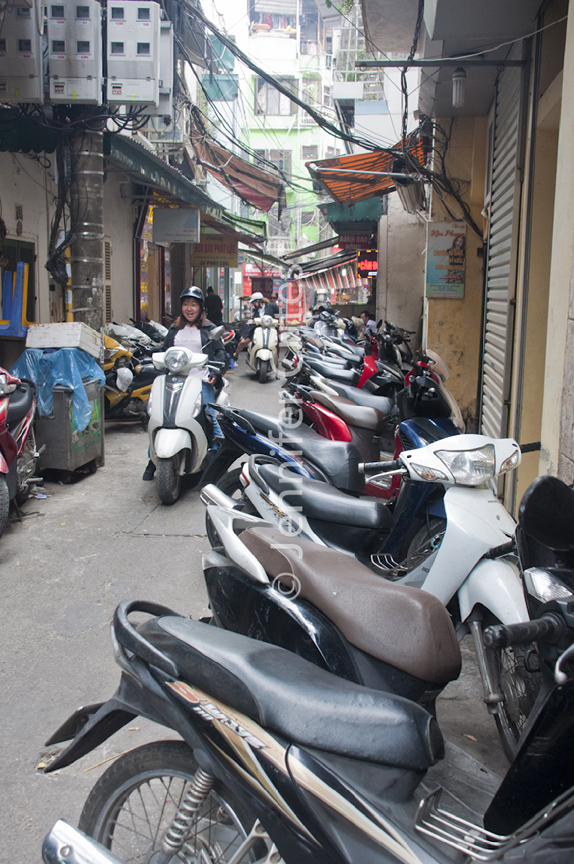
Categories: Architecture, Asia, culture, Food, History, Photography, Shopping, Travel, Uncategorized, Vietnam
Tags: architecture, food, Hanoi, history, people, photography, photos, travel, Vietnam
Leave a comment
A Poignant Visit to Hoa Lo Prison (Hanoi Hilton) in Vietnam
 Yesterday was the 75th anniversary of the closing of Auschwitz, the concentration camp in which Hitler’s minions killed more than a million Jews during WWII. On the news last night, survivors told their stories, and they made me think of other prisons and the people who were subjected to beatings, torture and murder by their fellow human beings.
Yesterday was the 75th anniversary of the closing of Auschwitz, the concentration camp in which Hitler’s minions killed more than a million Jews during WWII. On the news last night, survivors told their stories, and they made me think of other prisons and the people who were subjected to beatings, torture and murder by their fellow human beings.
My father was a British POW for 5 years in Germany during WWII. He was not in a concentration camp, thank goodness. He was captured at Dunkirk, force marched through Germany (during which many of his fellow soldiers died), and held captive in three different East German prisons. Why three? Because he felt it was his duty to escape, which he did, twice. But each time he was recaptured and, I’m sure, punished severely and sent to a different stalag. As the war ended, the guards fled and left the prison gates open, and he was able to make his way back across Germany and France to England
A few months ago, I visited Hanoi’s Hoa Lo Prison, which is now a museum. It reminded me of my dad’s imprisonment and that we must be constantly on guard against the wars, hatred and divisiveness that causes such inhumane treatment of others.
Hoa Lo Prison was built by the French from 1886-1889 and 1898-1901 to hold mainly Vietnamese political prisoners agitating for independence during the French occupation of Vietnam when the country was part of French Indochina. The prison’s name can be translated as “fiery furnace,” Hell’s hole,” or “stove” because on the same-named street outside its walls in pre-colonial times could be found a concentration of stores selling wood and coal-fire stoves.
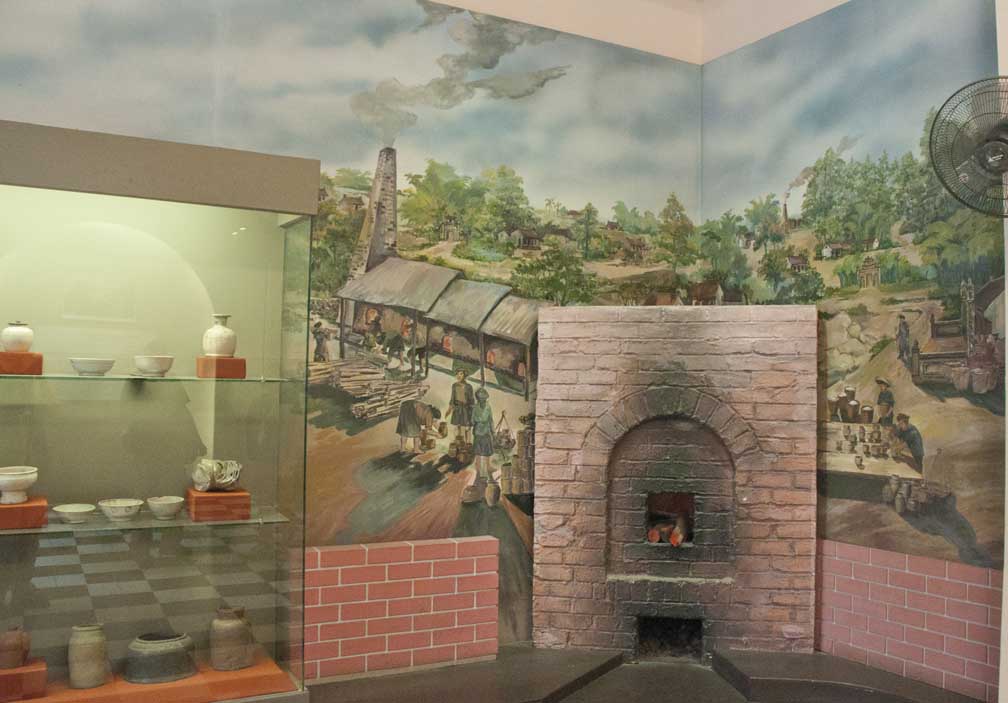
exhibit showing a mural of the stove/oven street outside the prison in pre-colonial days

Maison Centrale sign above entry door

Originally built in Hanoi’s French Quarter to hold 460 prisoners, it was renovated in 1913 to hold 600. But it was nevertheless often overcrowded, holding 730 by 1916, 895 in 1922 and 1,430 in 1933. By 1954, it held more than 2,000 people in subhuman conditions and had become a symbol of colonialist exploitation. Some of those prisoners were women—300 at one count—held in a separate stockade measuring 270 square meters. One display extolls the bravery of these women as they “organized schools to propagate politics and culture in order to improve their ability to fight and make contributions to the revolution.”
The prison also exemplified the bitterness of the Vietnamese who were subject to torture and execution. The French called the prison Maison Centrale (Central House), which is still the designation for prisons in France that hold dangerous or long-sentence detainees.

Viet women prisoners

women’s cell

What they ate
During the 1910s through 1930s, street peddlers passed messages in through the jail’s windows, and tossed tobacco and opium over the walls. Letters and packets would be thrown out to the street in the opposite direction. Many of the future leading figures in Communist North Vietnam spent time in Maison Centrale during the 1930s and ‘40s.
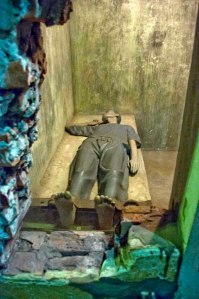

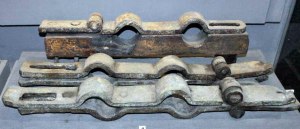
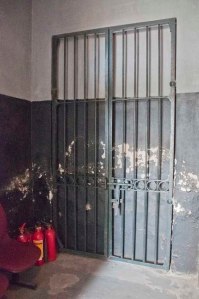

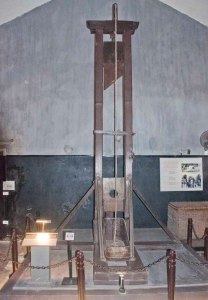
guillotine

sign showing French regulations
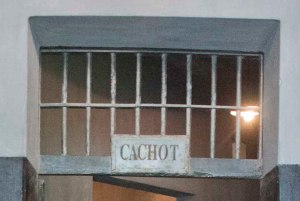
cachot dungeon sign over door
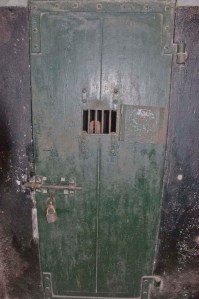
prisoner peering through bars in dungeon cell door

3D art showing defiant Viet prisoners
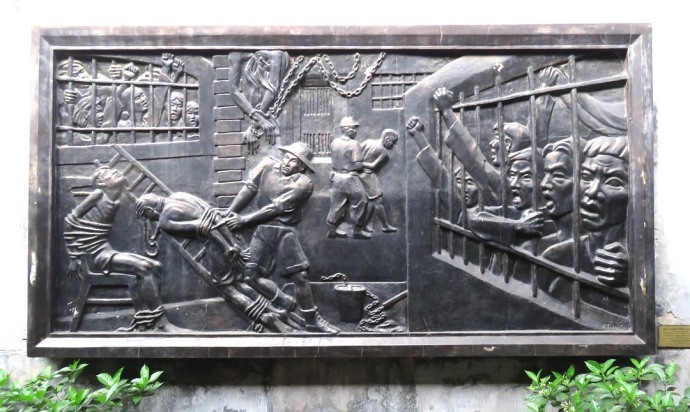
3D art showing the French beating a Viet prisoner

multi-prisoner cell, French era
Following defeat at the Battle of Dien Bien Phu and the 1954 Geneva Accords, the French left Hanoi, and authority for the prison passed to the Democratic Republic of Vietnam. The building served as an education center for revolutionary doctrine and activity, and was kept around to mark its historical significance to the North Vietnamese.
The Vietnam/American War
Americans refer to it as the Vietnam war. Vietnamese call it the American war. Whatever it’s called, Hoa Lo was used to house, torture and interrogate captured servicemen, mostly American pilots shot down during bombing raids. Although North Vietnam was a signatory of the Third Geneva Convention of 1949, which demanded “decent and humane treatment” of prisoners of war, severe torture methods—such as rope bindings, leg irons, beatings and prolonged solitary confinement—were employed, according to prisoners of war released from this and other North Vietnamese prisons during the Johnson administration circa 1969.

red-and-white striped prison outfit next to a photo of the first US airman captured in 1964

prison kitchen
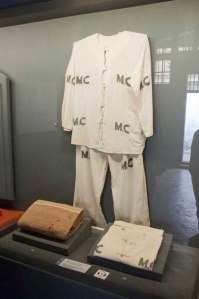
white Maison Centrale prison outfit


Exhibit of US pilot’s flight suite and parachute

Exhibit showing bombed-out Viet city
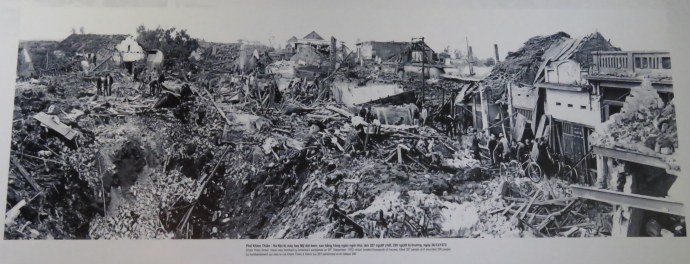
b/w photo of US-bombed hospital in Vietnam
During 1969, Vietnamese officials broadcast a series of coerced statements from American prisoners that supported the notion that American prisoners were treated well. A photo of a smiling John McCain (imprisoned from 1967-1973) stands out on one wall as does another photo of smiling American prisoners playing basketball.
In the museum today, atrocities perpetrated by the French on the Vietnamese are cruelly depicted, while other exhibits show the “fun” that American prisoners had there. Of course, that was not the case, and some POW’s sarcastically nicknamed the place the “Hanoi Hilton.” A pilot named Bob Shumaker was the first to write it down, carving “Welcome to the Hanoi Hilton” on the handle of a pail to greet the arrival of Air Force Lt. Robert Peel. Vietnamese officials used the nickname to show that Americans thought of the prison as a hotel.
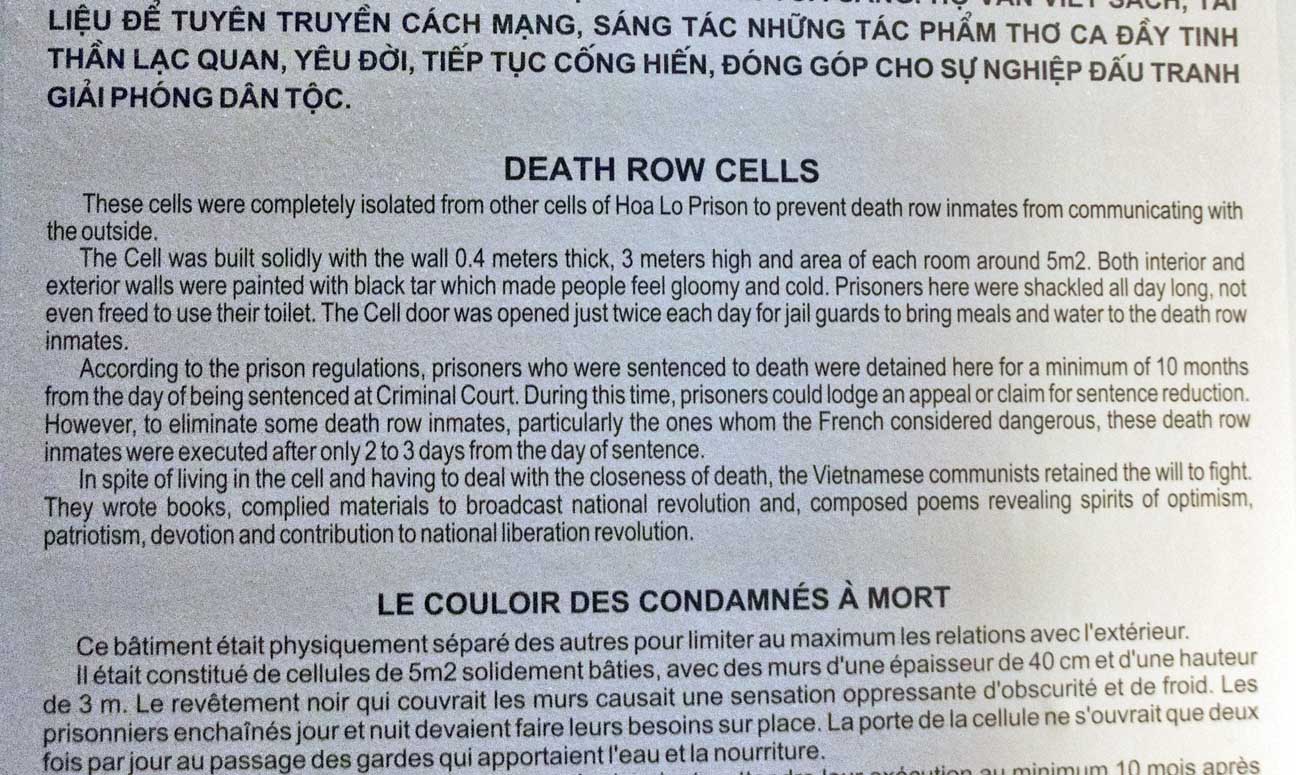
death-cells explanation sign

death-cells layout

Death-row cells

miniature layout of prison
After the war, the Vietnamese government adopted the position that no prisoners were tortured during the war and that claims were fabricated, but that Vietnam wanted to move past the issue and establish better relations with the U.S. However, eyewitness accounts by American servicemen present a different account of their captivity. USAF fighter pilot and POW from 1965 to 1973 and senior ranking POW Robinson Risner wrote the book, Passing of the Night, which detailed his seven years at the Hanoi Hilton. His book and those by McCain (Faith of My Fathers) and dozens of others depicted Hoa Lo and the other prisons as places where murder, beatings, broken bones, teeth and eardrums, dislocated limbs, starvation, serving of food contaminated with human and animal feces, and medical neglect of infections and tropical disease occurred.
Two U.S. Air Force officers, Charles Tanner and Ross Terry, rather than face torture, concocted a story about two other members of their squadron who had been court-martialed for refusing to fly missions against the north. Thrilled with this piece of propaganda, the Vietnamese told the story to visiting Japanese Communists, and it filtered back to the U.S. Unfortunately for Tanner and Terry, they had called their imaginary pilots Clark Kent and Ben Casey (TV icons). When the Vietnamese realized they had been made fools of, the two prisoners were tortured.
The final prisoners were not released until 1973, some having been held since 1964. After the implementation of the 1973 Paris Peace Accords, neither the U.S. nor its allies ever formally charged North Vietnam with the war crimes committed there.
Despite pleas from war veterans and party members, the prison site was sold to a Singapore-Vietnamese joint venture and turned into a hotel and shopping complex. But as part of the deal, the developers had to leave a portion of the prison for use as a museum. Displays mainly show the prison during the French colonial period, including the guillotine room, and quarters for male and female Vietnamese political prisoners. Propaganda displays for American POWs show them playing chess, shooting pool, gardening, raising chickens and receiving large fish and eggs for food.

photo of prison exterior

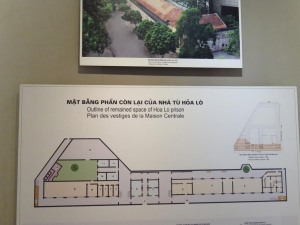
Outline of prison museum space
One display listing “Camp Regulations” starts out by stating, “American servicemen participating in the war of aggression by U.S. administration in Vietnam and caught in the act while perpetrating barbarous crimes against the Vietnamese land and people, should have been duly punished according to their criminal acts, but the Government and people of Vietnam, endowed with noble and humanitarian traditions, have given those captured American servicemen the opportunity to benefit a lenient and generous policy by affording them a normal life in the detention camps as practical conditions of Viet-Nam permit it and conforming to the situation in which the war is still on.” (I have reprinted this statement and the following regulations exactly as originally written)
It continues, “Detainees are to observe and carry out the following regulations of the camp:
I- Detainees must strictly obey orders and follow instructions given them by Vietnamese officers and armymen on duty in the camp.
II- Detainees must be polite towards every Vietnamese in the camp.
III- Inside the detention rooms, as well as outside when allowed, detainees must not make noise or create noise. Quarrel and fighting between detainees are forbidden. In time of rest, total silence is imposed.
IV- Detainees must not bring back to detention room any object whatsoever without the camp authorities permit it.
V- In case of sickness or sign of sickness is felt, detainees must immediately inform the camp for the medical officer to check and cure.
VI- Detainees must assure hygiene of the camp, take care of personal items provided by the camp as well as of any other thing for collective use.
VII- In case of air alarm, detainees must keep order and silence, and follow the camp regulations on security.
VIII- In need of something, detainees should address themselves to Vietnamese armymen standing nearby by announcing two words “BAO CAO” (means “report”), and should wait if no English-speaking people was available yet.
IX- In the detention rooms, every detainees are equal with each other. Anyone does have the right to free thinking, feeling, preying (sic.) etc… and no one is permitted to coerce any other into following his own opinion.
X- Violation of the regulations shall be punished.”

sign Cachot, meaning dungeon
Many exhibits at the museum brought back memories of my father’s imprisonment in Germany, especially the remnant of an underground sewer, which was used by Vietnamese prisoners to escape. My dad told me how he and his buddies would leave the stalag through the sewer under the toilets, kill a pig for food, eat, and return before they were missed. It was the only way they could get any nourishing food.
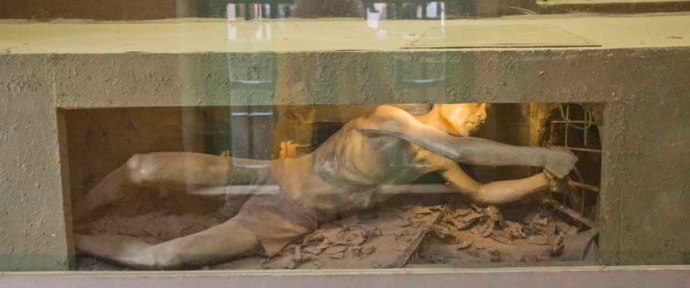
Viet prisoner cutting underground sewer bars

sewer escape route

sewer escape route with cut iron bars
I can only imagine the horrors that prisoners, both Vietnamese and American, suffered at the hands of their captors. Visiting former prisons such as Hoa Lo, and actually standing in the places where these atrocities took place makes me determined to fight the cruelty that human beings seem willing to exert upon each other.
Categories: Asia, History, Travel, Vietnam
Tags: Hanoi Hilton, prisoners of war, prisons, Vietnam, Vietnam war, war
2 Comments
